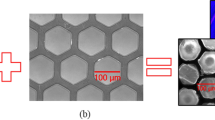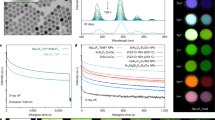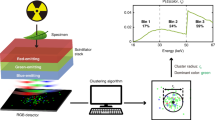Abstract
Conventional flat-panel X-ray detectors suffer from image distortion and non-uniformity when imaging non-planar geometries. Flexible X-ray detectors can conformally fit on a non-planar target surface and thus reduce image distortion. However, it is challenging to create thin-film transistors and photodetector backplanes that offer the necessary mechanical flexibility while maintaining good carrier mobility and photoresponsivity. Here we report a flexible active-matrix X-ray detector that has a backplane based on two-dimensional molybdenum disulfide (MoS2) transistors and graphene/MoS2 photodetectors. The backplane covers a large area of 3 cm × 3 cm with a total of 3,600 pixels, and exhibits a high electron mobility of 17.31 cm2 V−1 s−1 and a photoresponsivity of 9.37 A W−1 near the scintillator emission wavelength (544 nm). We use generative adversarial network-based post-processing to suppress inherent device noise, and show that the approach can provide high-quality images under lower X-ray exposure than typically needed for medical diagnosis and industrial inspection.
This is a preview of subscription content, access via your institution
Access options
Access Nature and 54 other Nature Portfolio journals
Get Nature+, our best-value online-access subscription
$32.99 / 30 days
cancel any time
Subscribe to this journal
Receive 12 digital issues and online access to articles
$119.00 per year
only $9.92 per issue
Buy this article
- Purchase on SpringerLink
- Instant access to full article PDF
Prices may be subject to local taxes which are calculated during checkout





Similar content being viewed by others
Data availability
Source data are provided with this paper. Other data that support the findings of this study are available from the corresponding authors upon reasonable request.
References
van Breemen, A. J. et al. Curved digital X-ray detectors. npj Flex. Electron. 4, 22 (2020).
Liu, J. et al. Flexible, printable soft‐X‐ray detectors based on all‐inorganic perovskite quantum dots. Adv. Mater. 31, 1901644 (2019).
Zhao, J. et al. Perovskite-filled membranes for flexible and large-area direct-conversion X-ray detector arrays. Nat. Photonics 14, 612–617 (2020).
Yokota, T. et al. A conformable imager for biometric authentication and vital sign measurement. Nat. Electron. 3, 113–121 (2020).
Ko, H. C. et al. A hemispherical electronic eye camera based on compressible silicon optoelectronics. Nature 454, 748–753 (2008).
Kim, Y. C. et al. Printable organometallic perovskite enables large-area, low-dose X-ray imaging. Nature 550, 87–91 (2017).
Wei, H. et al. Sensitive X-ray detectors made of methylammonium lead tribromide perovskite single crystals. Nat. Photonics 10, 333–339 (2016).
Yakunin, S. et al. Detection of X-ray photons by solution-processed lead halide perovskites. Nat. Photonics 9, 444–449 (2015).
Wei, W. et al. Monolithic integration of hybrid perovskite single crystals with heterogenous substrate for highly sensitive X-ray imaging. Nat. Photonics 11, 315–321 (2017).
Martin, C. Optimisation in general radiography. Biomed. Imaging Interv. J. 3, e18 (2007).
Kamiya, T., Nomura, K. & Hosono, H. Present status of amorphous In–Ga–Zn–O thin-film transistors. Sci. Technol. Adv. Mater. 11, 044305 (2010).
Li, G., Wang, Y., Huang, L. & Sun, W. Research progress of high-sensitivity perovskite photodetectors: a review of photodetectors: noise, structure, and materials. ACS Appl. Electron. Mater. 4, 1485–1505 (2022).
Hwangbo, S., Hu, L., Hoang, A. T., Choi, J. Y. & Ahn, J.-H. Wafer-scale monolithic integration of full-colour micro-LED display using MoS2 transistor. Nat. Nanotechnol. 17, 500–506 (2022).
Dodda, A. et al. Active pixel sensor matrix based on monolayer MoS2 phototransistor array. Nat. Mater. 21, 1379–1387 (2022).
Park, Y. J. et al. All MoS2-based large area, skin-attachable active-matrix tactile sensor. ACS Nano 13, 3023–3030 (2019).
Thai, K. Y. et al. MoS2/graphene photodetector array with strain-modulated photoresponse up to the near-infrared regime. ACS Nano 15, 12836–12846 (2021).
Cui, X. et al. Multi-terminal transport measurements of MoS2 using a van der Waals heterostructure device platform. Nat. Nanotechnol. 10, 534–540 (2015).
Choi, C. et al. Human eye-inspired soft optoelectronic device using high-density MoS2-graphene curved image sensor array. Nat. Commun. 8, 1664 (2017).
Kang, J. H. et al. Monolithic 3D integration of 2D materials-based electronics towards ultimate edge computing solutions. Nat. Mater. 22, 1470–1477 (2023).
Cheng, M.-H. et al. Amorphous InSnZnO thin-film transistor voltage-mode active pixel sensor circuits for indirect X-ray imagers. IEEE Trans. Electron Devices 63, 4802–4810 (2016).
Paul, C. R. Transmission Lines in Digital and Analog Electronic Systems: Signal Integrity and Crosstalk (Wiley, 2011).
Li, W. et al. Approaching the quantum limit in two-dimensional semiconductor contacts. Nature 613, 274–279 (2023).
Shen, P.-C. et al. Ultralow contact resistance between semimetal and monolayer semiconductors. Nature 593, 211–217 (2021).
Mikla, V. I. & Mikla, V. V. Medical Imaging Technology (Elsevier, 2013).
Vaniqui, A. et al. The effect of different image reconstruction techniques on pre-clinical quantitative imaging and dual-energy CT. Br. J. Radiol. 92, 20180447 (2019).
Kwak, J. Y. Absorption coefficient estimation of thin MoS2 film using attenuation of silicon substrate Raman signal. Results Phys. 13, 102202 (2019).
Fuentes-Hernandez, C. et al. Large-area low-noise flexible organic photodiodes for detecting faint visible light. Science 370, 698–701 (2020).
Park, B. et al. 5.6 A 400 × 200 600 fps 117.7 dB-DR SPAD X-ray detector with seamless global shutter and time-encoded extrapolation counter. In Proc. IEEE International Solid-State Circuits Conference 100–102 (IEEE, 2023).
Kasap, S. Optoelectronics and Photonics (Pearson Education, 2013).
Sharma, R. et al. Radiation dose to patients from X-ray radiographic examinations using computed radiography imaging system. J. Med. Phys. 40, 29–37 (2015).
Arandjić, D., Košutić, D. & Lazarević, D. Patient protection in dental radiology: influence of exposure time on patient dose. Serbian J. Electric. Eng. 6, 489–494 (2009).
Shrivastava, A. & Gupta, V. B. Methods for the determination of limit of detection and limit of quantitation of the analytical methods. Chron. Young Sci. 2, 21–25 (2011).
Thirimanne, H. et al. High sensitivity organic inorganic hybrid X-ray detectors with direct transduction and broadband response. Nat. Commun. 9, 2926 (2018).
Huang, W.-C., Tseng, Z.-C., Hsueh, W.-J., Liao, S.-Y. & Huang, C.-Y. X-ray detectors based on amorphous InGaZnO thin films. IEEE Trans. Electron Devices 70, 3690–3694 (2023).
Pan, L., Shrestha, S., Taylor, N., Nie, W. & Cao, L. R. Determination of X-ray detection limit and applications in perovskite X-ray detectors. Nat. Commun. 12, 5258 (2021).
Rocha, J. et al. X-ray image detector based on light guides and scintillators. IEEE Sens. J. 9, 1154–1159 (2009).
Piotrowski, I. et al. Carcinogenesis induced by low-dose radiation. Radiol. Oncol. 51, 369–377 (2017).
Hoang, A. T. et al. Low-temperature growth of MoS2 on polymer and thin glass substrates for flexible electronics. Nat. Nanotechnol. 18, 1439–1447 (2023).
Acknowledgements
This work was supported by the Ministry of Trade, Industry, and Energy (MOTIE) grant (20012355), the National Research Foundation of Korea (RS-2024-00435661), and Lee Youn Jae Fellow Program and International Joint Research Grant by Yonsei University. Y.C. acknowledges support from the National Key R&D Program of China (2022YFA1203804) and National Natural Science Foundation of China (62425405).
Author information
Authors and Affiliations
Contributions
J.-H.A. planned and supervised the project. B.J.K. and A.T.H. designed the experiment. B.J.K., B.S., Y.C. and J.-H.A prepared the manuscript. A.T.H. grew MoS2 on the SiO2 wafer. B.J.K. and S.Y. performed the finite element simulation. J.H. designed the read-out circuit. S.J., A.K.K. and D.X. analysed the experimental data. Y.C., B.S. and J.W. designed and conducted the post-processing.
Corresponding authors
Ethics declarations
Competing interests
The authors declare no competing interests.
Peer review
Peer review information
Nature Electronics thanks Koruwakankanange Jayawardena and Hang Zhou for their contribution to the peer review of this work.
Additional information
Publisher’s note Springer Nature remains neutral with regard to jurisdictional claims in published maps and institutional affiliations.
Supplementary information
Supplementary Information
Supplementary Figs. 1–13, Tables 1–3 and Note.
Source data
Source Data Fig. 2
Fig. 2 source data.
Source Data Fig. 3
Fig. 3 source data.
Source Data Fig. 4
Fig. 4 source data.
Source Data Fig. 5
Fig. 5 source data.
Rights and permissions
Springer Nature or its licensor (e.g. a society or other partner) holds exclusive rights to this article under a publishing agreement with the author(s) or other rightsholder(s); author self-archiving of the accepted manuscript version of this article is solely governed by the terms of such publishing agreement and applicable law.
About this article
Cite this article
Kim, B.J., Shao, B., Hoang, A.T. et al. A flexible active-matrix X-ray detector with a backplane based on two-dimensional materials. Nat Electron 8, 147–156 (2025). https://doi.org/10.1038/s41928-024-01317-7
Received:
Accepted:
Published:
Issue date:
DOI: https://doi.org/10.1038/s41928-024-01317-7



